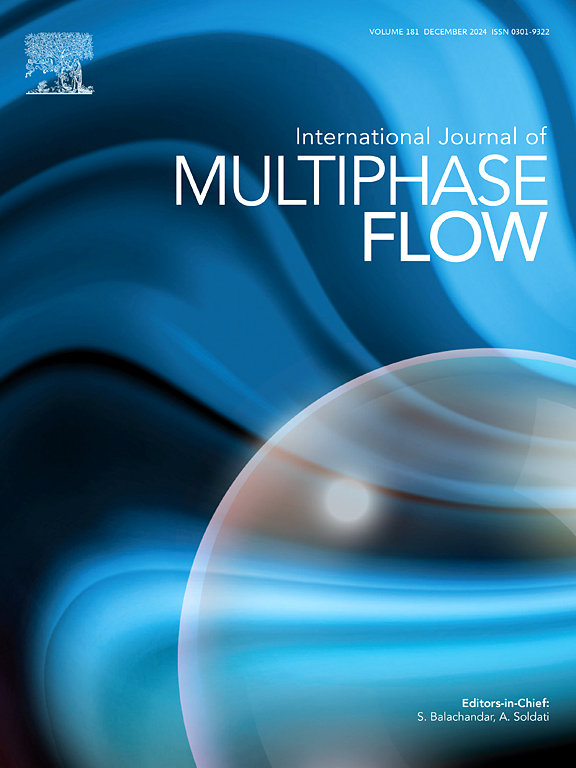Effects of inflow conditions on plunging jet dynamics
IF 3.8
2区 工程技术
Q1 MECHANICS
International Journal of Multiphase Flow
Pub Date : 2025-07-23
DOI:10.1016/j.ijmultiphaseflow.2025.105364
引用次数: 0
Abstract
We present an experimental study on the influence of inflow characteristics on the dynamics of plunging jets. Several nozzle configurations were tested to establish a link between upstream conditions, the development of a water jet in air, and the subsequent bubble cloud generated upon impact with the water pool. Our study concerns jets with a nozzle diameter of and fall heights up to 1.6 m. Both the impact of the nozzle geometry and the upstream pipe length were evaluated, covering inflow velocities within the range , Reynolds numbers in the range and Weber numbers in the range . Complementary experimental techniques were applied to investigate several properties of the jet before and after the impact, that include optical probes, high-speed imaging and pressure sensors.
Differences between jets from a conical nozzle and a cylindrical nozzle with a sharp section change were examined. Our results show that the length of the pipe connected to the nozzle, that covers from 27 to 131 nozzle diameters, influences the jet’s breakup length, a phenomenon that increases with the pipe’s length. Moreover, this effect presents differences in terms of the nozzle properties, being stronger for the conical configuration. Furthermore, the breakup length is greater for the conical nozzle, whereas the cylindrical nozzle exhibits higher variability and more disturbances, leading to more extreme events. High-speed camera footage confirms that the jet from the cylindrical nozzle is rougher than that from the conical nozzle. Nevertheless, axial turbulence measurements do not differentiate between the two configurations, as all cases present small and similar values of turbulence intensity. Finally, the jet’s entrained airflow was analyzed in terms of penetration depth, bubble size, and mean velocity. This was achieved by means of an optical probe that can quantify the local void fraction and also the velocity of the air/water interface. We find that the conical nozzle produces a jet plume with a larger penetration depth, containing bubbles with smaller chords and velocity.
Globally, our study shows that the upstream conditions of a plunging jet are relevant for all studied quantities. Even a fully developed pipe inflow will be strongly affected by secondary currents generated at the nozzle.

入流条件对突降射流动力学的影响
本文对进流特性对突降射流动力学的影响进行了实验研究。测试了几种喷嘴配置,以建立上游条件、空气中水射流的发展以及与水池碰撞后产生的气泡云之间的联系。我们的研究涉及喷嘴直径为7.6mm,下落高度为1.6 m的射流。对喷嘴几何形状和上游管道长度的影响进行了评估,包括流入速度范围为(1.2,10.4)m/s,雷诺数范围为(24×103,79×103)和韦伯数范围为(1.0,11.2)。研究人员采用了互补的实验技术,包括光学探针、高速成像和压力传感器,研究了撞击前后射流的几种特性。研究了锥形喷嘴和圆筒形喷嘴射流的差异。研究结果表明,与喷嘴连接的管道长度(覆盖27 ~ 131个喷嘴直径)影响射流的破裂长度,且破裂长度随管道长度的增加而增加。此外,这种影响在喷嘴性能方面表现出差异,对于锥形结构来说更强。此外,锥形喷嘴的破裂长度更大,而圆柱形喷嘴则表现出更大的变异性和更多的干扰,导致更极端的事件。高速摄像机的镜头证实了圆柱形喷嘴的喷射比锥形喷嘴的喷射更粗糙。然而,轴向湍流测量并不能区分这两种结构,因为所有情况下的湍流强度都很小且相似。最后,从穿透深度、气泡大小和平均速度三个方面分析了射流的夹带气流。这是通过光学探针实现的,该探针可以量化局部空隙率和空气/水界面的速度。我们发现锥形喷嘴产生的射流柱穿透深度更大,包含的气泡弦值和速度都更小。从整体上看,我们的研究表明,俯冲射流的上游条件与所有研究量都相关。即使完全发展的管道流入也会受到喷嘴处产生的二次流的强烈影响。
本文章由计算机程序翻译,如有差异,请以英文原文为准。
求助全文
约1分钟内获得全文
求助全文
来源期刊
CiteScore
7.30
自引率
10.50%
发文量
244
审稿时长
4 months
期刊介绍:
The International Journal of Multiphase Flow publishes analytical, numerical and experimental articles of lasting interest. The scope of the journal includes all aspects of mass, momentum and energy exchange phenomena among different phases such as occur in disperse flows, gas–liquid and liquid–liquid flows, flows in porous media, boiling, granular flows and others.
The journal publishes full papers, brief communications and conference announcements.

 求助内容:
求助内容: 应助结果提醒方式:
应助结果提醒方式:


